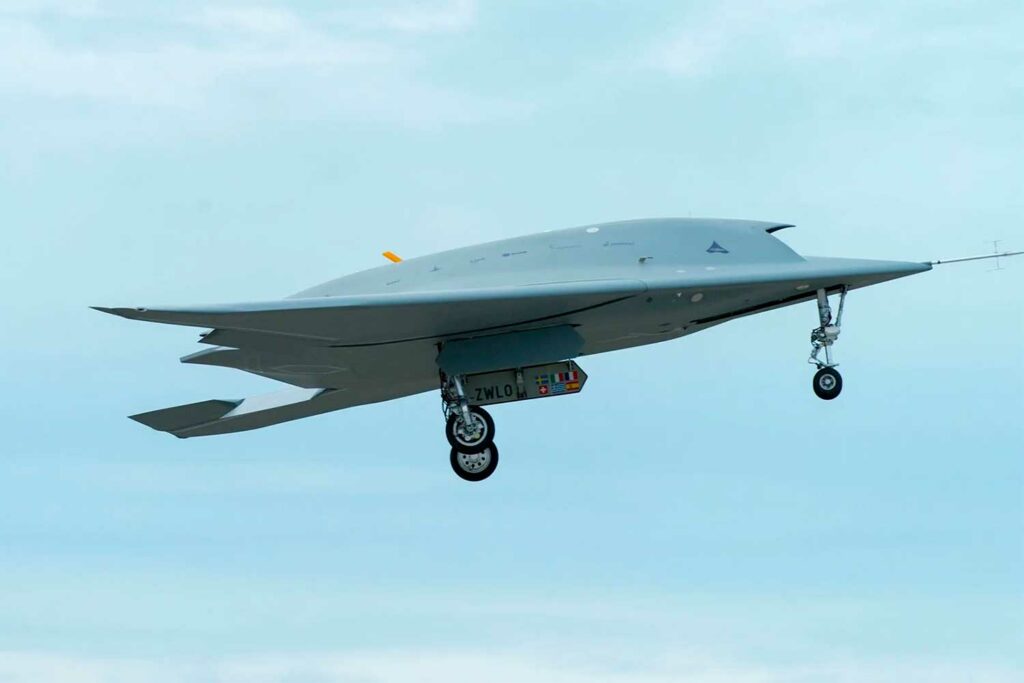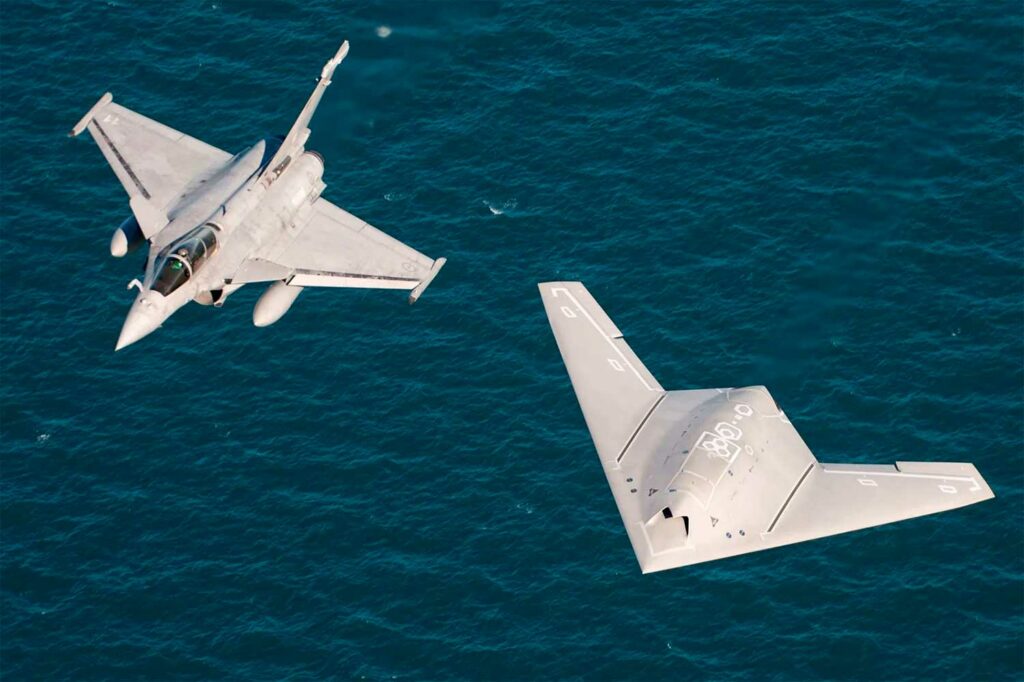
Dassault is developing a stealth combat drone powered by an M88 engine to accompany the Rafale F5 on manned-unmanned teaming missions.
France is strengthening its position in the field of combat air systems with an ambitious project: the development of a large stealth combat drone designed to operate alongside the Rafale F5 in MUMT (Manned-Unmanned Teaming) missions. Led by Dassault Aviation in partnership with the French Defense Procurement Agency (DGA), this unmanned aircraft will be powered by a Safran M88 engine, identical to the one already used in the Rafale.
With a weight comparable to that of a Mirage 2000, this drone – scheduled to enter service in 2033 – is designed to carry out offensive missions in contested environments, in particular strikes against enemy ground-to-air defense systems. Cooperation with a piloted Rafale will enable roles to be shared between the platforms, maximizing operational efficiency while reducing human risk.
This program is part of the French military modernization strategy and the desire to offer sovereign solutions for export to compete with American and Chinese systems. It also marks a decisive step for Dassault Aviation, which is crossing a technological threshold after the experience of the nEUROn demonstrator. This article analyzes in detail the characteristics of the future drone, its integration into the Rafale F5, the industrial challenges of the program, and its strategic implications.

The design of the stealth drone and its technical characteristics
The drone under development, sometimes referred to as “nEUROn 2.0,” is distinguished by its dimensions, which are similar to those of a Mirage 2000, with an estimated takeoff weight of 17.5 tons. It is therefore a fully-fledged combat aircraft capable of carrying out complex offensive missions in heavily defended areas. This change in scale, compared to the 6-ton nEUROn demonstrator, poses significant technical challenges, particularly in terms of stealth, propulsion, and payload.
The choice of the Safran M88 engine, proven on the Rafale, guarantees sufficient power while ensuring logistical compatibility with the maintenance chains already in service. This compact turbofan engine delivers approximately 75 kilonewtons of thrust in afterburner, with a low infrared signature and optimized fuel consumption. Its ease of maintenance and modularity make it a logical choice for a system intended for intensive use.
The drone will be equipped with an internal weapons bay, avoiding any external appendages that could compromise stealth. The overall architecture will favor angular shapes, fairing air intakes, radar-absorbing composite materials, and advanced thermal management. The airframe should incorporate a retractable landing gear, passive sensors, and avionics specifically adapted for semi-autonomous piloting.
This combat drone is designed to perform SEAD/DEAD (Suppression/Destruction of Enemy Air Defenses) missions. It will be able to fly at medium or high altitudes, identify active radars, transmit coordinates to a Rafale, or carry out strikes itself. Its payload, which is still confidential, could allow it to carry AASM Hammer air-to-ground missiles, or even anti-radar missiles, in limited quantities but sufficient to neutralize priority targets.
Full integration into the MUMT concept with the Rafale F5
The project is based on close operational cooperation between humans and machines, via a system known as “teaming.” The Rafale F5, a modernized version expected from 2030, will be equipped with advanced data links, enabling it to control one or more drones in flight. This secure digital link will enable dynamic distribution of roles during missions: detection, jamming, target designation, or strike.
While capable of operating autonomously, the drone will remain under the supervision of the Rafale pilot. The latter will have an interface in their cockpit enabling them to transmit orders, access the drone’s sensor feeds and even authorize firing. Control will probably be via a SATCOM-type link or a direct tactical link, within an operational radius of approximately 300 kilometers.
The strategic advantage is twofold: the drone can enter high-risk areas, designate a target without endangering the manned aircraft, and act as a force multiplier. In the event of jamming, it will be able to continue its mission partially autonomously, according to predefined scenarios.
This type of operation requires clear doctrine and appropriate chains of command. The DGA is working with the armed forces to define these operating procedures, in line with future NATO requirements. The modular approach of the Rafale F5, which incorporates a new electronic warfare system and an active phased array radar (AESA), will enable seamless data fusion between the aircraft and the drone.
A strategic lever for French sovereignty and the defense industry
With this program, France is becoming one of the few countries to design a large stealth combat drone integrated into an existing fighter platform. It thus joins an exclusive club dominated by the United States (with the Skyborg project and Loyal Wingman drones) and China (with the FH-97A). Unlike its competitors, the French system relies on industrial sectors that are entirely controlled within the country, from the airframe to the engine.
This choice of industrial autonomy is key. It reduces dependence on foreign suppliers and ensures total freedom of use. In addition, the drone can be offered for export in line with the Rafale strategy. Several potential customers in Europe, the Middle East, and Asia could be interested in a joint Rafale + drone solution, capable of covering a broader operational spectrum with a smaller fleet.
The drone could also foreshadow certain modules of the SCAF program (Future Air Combat System), conducted with Germany and Spain. In the medium term, the technologies developed for the Rafale F5 and its companion drone could be transferred to the NGF (Next Generation Fighter), the core of the SCAF. This would give Dassault greater credibility in European industrial discussions.

Challenges to overcome to ensure the program’s success
The development of such a system presents considerable challenges, both technologically and industrially. Stealth is a demanding field that requires perfect mastery of shapes, materials, RAM (Radar Absorbent Material) coatings, and thermal signature. The transition from a demonstrator such as the nEUROn to an operational combat aircraft involves a leap forward in terms of robustness, connectivity, and the ability to operate in a joint network.
The engine is a second challenge. Although the M88 is a reliable engine, its integration into an unmanned airframe requires more rigorous thermal management in the absence of active human control. The mission management software will need to be able to adapt to different tactical scenarios, with sufficient onboard intelligence to make real-time decisions while remaining under supervision.
Industrialization will need to be smooth and coordinated between the various partners: Dassault for the airframe and integration, Safran for the engine, Thales for sensors and communications, MBDA for armament, and the DGA for capability validation.
The provisional schedule is ambitious: the first test flight is expected between 2029 and 2031, with operational qualification around 2033 and gradual entry into service from 2034. It will require sustained financial commitment and rigorous management, particularly in a constrained budgetary environment.
War Wings Daily is an independant magazine.